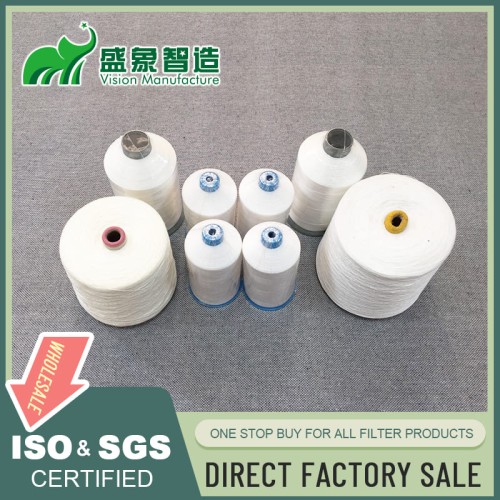
Weft Yarn: Weaving Strength and Versatility into Industrial Textiles and Filtration
I. Introduction
In the world of textile production, the structure of yarn plays a pivotal role in defining the characteristics and applications of the final product. Weft yarn, often overlooked, is crucial in weaving fabrics that are not only durable but also versatile enough to meet the demands of various industrial applications, including filtration. This introduction sheds light on the importance of weft yarn in industrial textiles and its relevance to enhancing filtration efficiency.
II. Understanding Weft Yarn
Weft yarn is the thread that is woven horizontally and interlaces with the warp yarn, which runs vertically on a loom. Unlike warp yarn, which typically bears the load and tension during weaving, weft yarn can be less taut, allowing for different material properties and applications. Key characteristics of weft yarn include its flexibility, strength, and ability to influence the texture and draping of the fabric, making it indispensable in both apparel and industrial textiles.
III. Types of Weft Yarn
Weft yarns vary widely in their composition and structure:
- Based on Material:
- Natural Fibers: Such as cotton, wool, and silk, known for their comfort and environmental friendliness.
- Synthetic Fibers: Including polyester, nylon, and polypropylene, which offer durability and resistance to environmental factors.
- Blended Yarns: Combine the benefits of natural and synthetic fibers.
- Based on Construction:
- Single Yarns: Consist of one strand of fiber twisted together.
- Plied Yarns: Made from two or more single yarns twisted together.
- Fancy Yarns: Have irregularities introduced by design to create textures.
Vision Filter utilizes a range of weft yarn types in their filtration products, tailoring materials to specific filtration needs.
IV. Manufacturing Process of Weft Yarn
The production of weft yarn involves several key steps:
- Fiber Preparation: Fibers are cleaned and prepared for spinning.
- Spinning Methods: Including ring spinning, open-end spinning, and air-jet spinning, each offering different benefits in terms of yarn strength and texture.
- Winding and Packaging: The spun yarn is wound onto bobbins and prepared for weaving.
- Quality Control: Rigorous testing ensures the yarn meets specific standards before it is used in textile production.
V. Properties of Weft Yarn
Weft yarn possesses several properties that make it suitable for a wide range of applications:
- Strength and Durability: Essential for industrial textiles where longevity is critical.
- Elasticity and Flexibility: Allows for ease of weaving and contributes to the comfort of the final fabric.
- Absorbency and Moisture Management: Important for applications such as apparel and certain types of filters.
- Thermal Properties and Chemical Resistance: Make it suitable for harsh environments.
VI. Applications of Weft Yarn in Textiles
Weft yarn is used extensively across various sectors:
- Apparel Fabrics: For clothing that requires strength and flexibility.
- Home Textiles: Such as curtains and upholstery.
- Industrial Textiles: Including automotive and aerospace applications.
- Geotextiles: For civil engineering and construction.
- Filtration Materials: Both woven and nonwoven filter fabrics benefit from the properties of weft yarn.
VII. Weft Yarn in Industrial Filtration
In filtration, weft yarn plays a crucial role:
- Woven Filter Fabrics: Utilize weft yarn for structural integrity.
- Impact on Filtration Efficiency: Properly selected weft yarn can enhance the filtering capabilities.
- Influence on Filter Cake Formation and Release: Affects how particles are captured and released during cleaning cycles.
- Contribution to Filter Strength and Durability: Ensures the filter withstands operational stresses.
- Customization Options: Weft yarn can be tailored to meet specific filtration requirements, a specialty of Vision Filter.
VIII. Choosing the Right Weft Yarn for Filtration
Selecting the appropriate weft yarn involves considering:
- Fiber Type, Yarn Count, and Twist: These factors determine the yarn’s suitability for different filtration scenarios.
- Matching Yarn Properties to Filtration Requirements: Ensures optimal performance.
- Balancing Performance and Cost: Essential for maintaining budget without compromising quality.
IX. Innovations in Weft Yarn Technology
Advancements in weft yarn technology include:
- Advanced Fiber Materials: Enhancing performance under extreme conditions.
- Nano-fiber Technologies: Improving filtration efficiency.
- Smart and Functional Yarns: Adding capabilities such as temperature regulation or antimicrobial properties.
- Sustainable Options: Including recycled fibers, aligning with environmental goals.
X. Environmental and Sustainability Aspects
Weft yarns contribute to sustainability through:
- Recyclability: Many weft yarns can be recycled, reducing waste.
- Energy Efficiency in Production: Advances in manufacturing technology reduce energy consumption.
- Use of Recycled Fibers: Supports the circular economy.
XI. Case Studies: Weft Yarn in Filtration Applications
Real-world applications demonstrate the effectiveness of weft yarn in improving air quality and solving complex filtration challenges. These case studies highlight the adaptability of weft yarn to meet diverse industrial needs, backed by customer testimonials.
XII. Future Trends in Weft Yarn Development
Emerging technologies and materials promise to further enhance the capabilities of weft yarn in filtration. Integration with smart systems and the development of new fiber blends are anticipated to drive significant advancements in the industry.
XIII. Conclusion
Weft yarn is a fundamental component in the textile and filtration industries, offering unmatched versatility and strength. Its role in enhancing the performance of industrial textiles and filtration systems cannot be overstated. For those seeking expert advice and cutting-edge solutions in filtration, Vision Filter remains a trusted resource, ready to provide comprehensive support tailored to your specific needs.
Leave a comment

